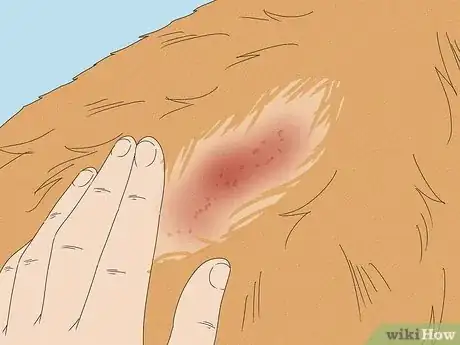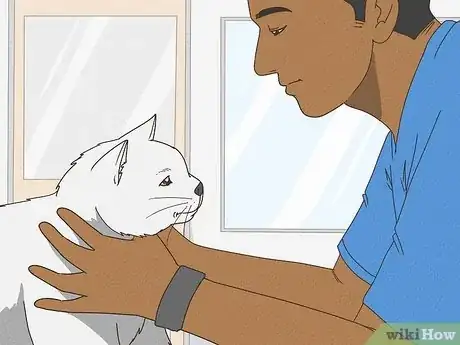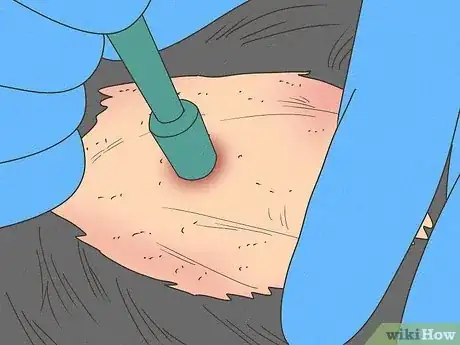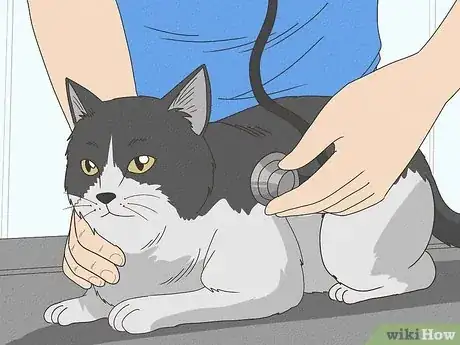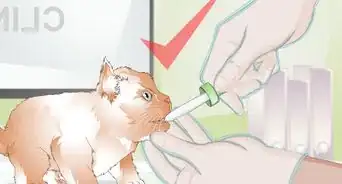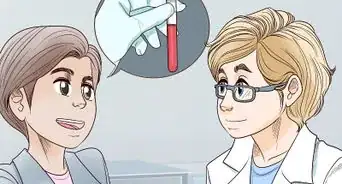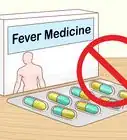This article was co-authored by Deanne Pawlisch, CVT, MA. Deanne Pawlisch is a Certified Veterinary Technician, who does corporate training for veterinary practices and has taught at the NAVTA-approved Veterinary Assistant Program at the Harper College in Illinois and in 2011 was elected to the board of the Veterinary Emergency and Critical Care Foundation. Deanne has been a Board Member of the Veterinary Emergency and Critical Care Foundation in San Antonio, Texas since 2011. She holds a BS in Anthropology from Loyola University and an MA in Anthropology from Northern Illinois University.
This article has been viewed 19,061 times.
Autoimmune skin disease is a condition in which the body's own immune system fights against itself. Instead of attacking pathogens or disease, the immune system attacks the body's own cells. In the case of autoimmune diseases of the skin in cats, this typically shows up in the form of skin irritation, blisters, and ulcers on the skin. If your cat has problematic areas on its skin that may be caused by this type of disease, you should have it looked at and treated by a board-certified veterinary dermatologist. With proper treatment and care, the irritation and pain sometimes associated with autoimmune skin diseases can be relieved.[1]
Steps
Identifying the Signs of Autoimmune Skin Disease
-
1Look for areas of fur loss. If your cat's skin is irritated by an autoimmune disease, it is likely that it will lose patches of fur. Areas of fur loss should be noted and the skin underneath should be watched for signs of irritation and discoloration.
- Cats can lose fur for a variety of reasons, including disease or simply over grooming. However, if your cat has areas of fur loss, they should be looked at by a veterinarian, no matter what you may think the cause is.
-
2Identify areas of irritated and red skin. When a cat's immune system goes after its own cells, this can cause those cells to become inflamed and irritated. Look for areas that are red and swollen, as well as areas where the skin is flaky or has discharge.[2]
- Irritation from autoimmune disease typically looks very different from irritation due to trauma or scratches. However, both should be looked at by a veterinarian if they don't go away after a few days and appear infected.
Advertisement -
3Look for blisters on the cat's skin. In addition to causing areas of fur loss and irritation, autoimmune skin disease tend to cause blisters and ulcers on the skin. There are especially common around the edges of the cat's eyes, lips, nose, and anus, where skin and mucosal tissues meet.[3]
- Depending on what type of autoimmune skin disease your cat has, its blisters or ulcers may be large or small. They may open up or remain inflated. They may be numerous or your cat may only have a few. Whatever type of blisters the cat has, they should be looked at by a veterinarian.
Getting a Veterinary Diagnosis and Treatment
-
1Take your cat to a board-certified veterinary dermatologist. If you suspect that your cat has an autoimmune skin disease, you should get it looked at by a board-certified veterinary dermatologist, which your veterinarian can refer you to. A condition like this can cause your cat a great deal discomfort if it goes untreated.[4]
- While it is important to get your cat looked at and treated, you do not need to bring your cat to a veterinarian immediately if you see one bare patch or blister. Instead, call your veterinary office, explain your cat's symptoms, and make an appointment for the cat to be looked at.
-
2Have a skin biopsy done. In addition to having a physical exam done, a board-certified veterinary dermatologist will need to run some tests to diagnose an autoimmune skin disorder. To get a definitive diagnosis, these tests will typically need to include a skin biopsy. This can be a painful procedure for a cat, but will allow the board-certified veterinary dermatologist to understand more clearly what it going on in the cat's cells.[5]
- If your cat needs a skin biopsy, they will be sedated and a local anesthetic block or anesthesia will be used.
-
3Discuss your board-certified veterinary dermatologist's diagnosis. Once your a board-certified veterinary dermatologist has finished its exam and testing of your cat, they will likely give you a diagnosis. However, it can be difficult to give an exact diagnosis for autoimmune diseases, so sometimes they may tell you what your cat likely has instead of a definitive diagnosis. Ask any questions you have at this point and discuss with the board-certified veterinary dermatologist why they have come to their conclusions. There are four common autoimmune skin diseases that the vet is likely to find. They include:[6]
- Pemphigus complex - usually causes blisters at the cat's mucocutaneous junctions, including the mouth, eyelids, lips, nostrils, and anus
- Bullous Pemphigoid - includes itchy and large red welts and hives, which often appear before blisters and ulcers on various parts of the body
- Systemic Lupus Erythematosus - a rare condition in cats that includes fever, stiffness or lameness, and blood abnormalities
- Discoid Lupus Erythematosus - rare in cats, causes loss of pigmentation around eyes and lips
-
4Begin a treatment regime. Depending on what type of autoimmune skin disease your cat has, the treatment may vary slightly. However, it is likely that your cat will be prescribed an immunosuppressant medication, which stops the immune system from fighting the cat's own body. The most common medication used is Atopica.[7]
- Additionally, if there is an underlying bacterial infection, your cat will also likely be prescribed antibiotics.
- In most cases, autoimmune skin diseases are controlled, not cured. This means that your cat will likely be on a treatment regime long term.
-
5Have follow up testing done regularly. Because autoimmune skin diseases can be serious and are usually not cured, your cat's condition will need to be evaluated regularly. This will allow the board-certified veterinary dermatologist to keep track of the progress of treatment, as well as keeping an eye on any side effects that might occur due to treatment.[8]
References
- ↑ https://vcahospitals.com/know-your-pet/autoimmune-skin-disease-in-cats
- ↑ https://vetmed-hospitals-smallanimal.sites.medinfo.ufl.edu/files/2011/09/Skin-Diseases-in-Cats-client-guide.pdf
- ↑ https://vcahospitals.com/know-your-pet/autoimmune-skin-disease-in-cats
- ↑ https://vcahospitals.com/know-your-pet/autoimmune-skin-disease-in-cats
- ↑ https://vcahospitals.com/know-your-pet/autoimmune-skin-disease-in-cats
- ↑ https://vcahospitals.com/know-your-pet/autoimmune-skin-disease-in-cats
- ↑ https://vcahospitals.com/know-your-pet/autoimmune-skin-disease-in-cats
- ↑ https://vetmed-hospitals-smallanimal.sites.medinfo.ufl.edu/files/2011/09/Skin-Diseases-in-Cats-client-guide.pdf

